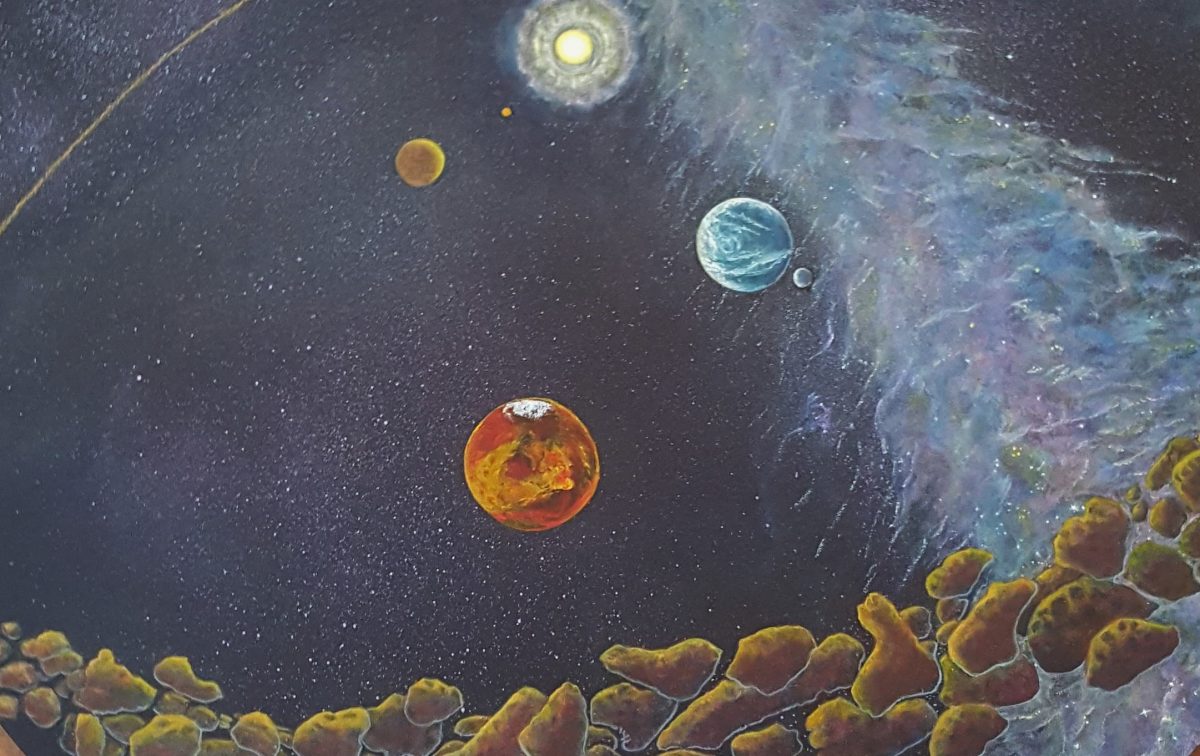
ADRIFT IN SPACE – Acrylic – Jud House
Further to my https://judsartwork.wordpress.com/2016/11/03/the-rules-of-art/ and my https://judsartwork.wordpress.com/2016/09/04/notes-on-painting/ posts, I’ve been pondering the variety of painting application techniques as I’ve worked on my ‘space’ paintings for my coming exhibition. It seems to me that there are no longer any rigid rules about what you use to apply your paint. And I so approve of that. It is not what you use to get there – it’s the completed artwork, its evocative image that’s important.
I paint in Acrylic, using synthetic brushes – they are the most compatible for the type of work I do. They are sympathetic to the Acrylic. They don’t interfere with the delicacy of some of the implied texture, and allow me to work into that so finely, pulling out images, teasing colour in between the texture. But I use so much more to apply my paint.

ANDROMEDA GALAXY – Acrylic – Jud House
For the ‘space’ paintings, I’ve applied very dark background Acrylic paint into a smooth medium-density layer upon which to cast the stars, galaxies, nebulae and matter of the universe. I’ve applied thin coloured layers of paint over this and lifted it off with various types of plastics (bags, wrappings, bubble-wrap) and toweling (paper, old tea towels, rags, washers) to show the space behind the implied texture above. I’ve then used the lifted off paint on the plastics to apply it in dabs and smears to other dry works – waste not, want not. I’ve painted the plastics with the paint, from neat to very wet and thin, and dabbed it on the works to build up colour and texture simultaneously. I’ve used my fingers, either with unintentional paint that I’ve then applied, or intentionally dipping my finger tips into the paint to apply it in touches, dabs, smears and rubbing, to add to or modify or correct a part of the artwork. On other artworks I’ve applied paint with skewers, knives, spoons, sponges, lids, and other miscellaneous objects that have come to hand. Some artworks have all been brushwork, from the initial background brush to finer brushes to paint on thin layers as washes, to build up and moderate the colours used.

Cross-section of GALAXIE GALORE – Acrylic – Jud House
Apart from a few larger sized flat brushes for blending larger areas and laying background paint onto smaller works, I prefer synthetic Dagger brushes. I’ve only found one brand that makes them, so far, but there must be others. They are so versatile – like having the best of all the brushes rolled into one. Turn them side-on and you can sweep layers (thin through to thick) of paint across the canvas, rolling slightly to create waves, twisting back and forth for unusual organic shapes, turning it on edge to create thin to thick lines, lifting it onto its tiny tip to draw a line as thin as hair. They only seem to come in 4 smallish sizes but your can do a lot with the largest of them that you can do with any other medium brush. I have other shaped synthetic brushes in jars, many tiny tip brushes that I used for the tiny line work although they tended to produced blobby little lines despite their minute size. But since my discovery of the Dagger brushes they remain in their jars unused, like the jars of hogshair brushes that I’ve not used for years (except one recently to paint around the outside edge of a thin-framed canvas) and that felt a bit weird.

REFLECTIONS – Acrylic – Jud House
Now for people who paint with Acrylic in thick, dense, structured brushwork, and who prefer the brushstrokes to show, and who build up ‘real’ texture that can be felt by touch, then hogshair (or synthetic) brushes are perfect for the tasks. I’ve done many of these works in the past, but for the work I’m producing at the moment the hogshair brushes are not needed. I may return to them at a future date – who knows – but I’m not discarding them or giving them away – they can sit in their jars till needed.
I know it’s a mundane and rather redundant thing to say, (and not aimed at experienced artists) but how you clean your brushes is so important. Just a quick wash under the tap will not suffice. Acrylic paint needs to be removed from the brush totally, or it will taint the next colour – unless you keep blue brushes for blue paint, red for red, etc The paint tints the synthetic brush a little more than it does the hogshair, and embeds at the base of the ferrule a little less than the hogshair. It needs to be massaged out. I usually rinse my water container (a takeaway tub) then rinse the brush in that, emptying and refilling as it dirties, then finally massage the brush up near the ferrule to dislodge the last particles possible. That way I don’t waste precious water, and end up with a clean brush. Actually I usually do several brushes at once – whatever I’ve used for that artwork till the water needed changing. The brushes last much longer and I don’t need to keep buying new ones.

NEBULAE – Acrylic – Jud House
As you can see, I quite approve of the freedom of equipment, impliment, and utensil use that artists of today have at their disposal. You are no longer considered to “paint like a child” if you get stuck into your artwork with your painted hands. You’re allowed to mix utensils as well as media these days. Go for it!
Jud House 6/01/2017
. . . . .
